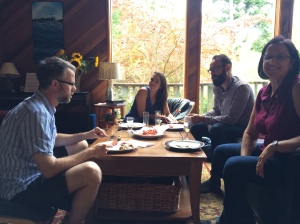I was really jazzed by our course readings on Habermas. His theories were down-to-earth, practical, applicable to the modern world, and very relevant to the current events unfolding during the week of reading and discussing his theories (Oct 26-Nov 1, 2014).
The readings about Habermas reminded me of one of another theory we read earlier. I looked back on the moodle posts and found it on page 135 of Robert T. Craig’s “Communication as a Field” article, right in the title of the section: “The Rhetorical Tradition: Communication as a Practical Art of Discourse”. (Craig, 1999, p. 135) Aha, read on!
A double-check on the meaning of public discourse revealed “A fancy way of saying public discussion. When you have people on a panel show, they are having public discourse – in other words, discussing something in public.” (Yahoo Answers, 2012)
Rhetoric was defined as “the art of effective or persuasive speaking or writing”. (Oxford, 2014)
Turning to Habermas, we find a description of public discourse in Peter Levine’s blog entry (Levine, 2012). Levine describes the way Habermas defines the public sphere as “the set of forums and institutions in which diverse people come together to talk about common concerns. It includes civic associations, editorial pages of newspapers, town meetings and parts of the internet.”
Back to Craig, who says about the rhetorical tradition: “This way of theorizing communication is useful for explaining why our participation in discourse, especially public discourse, is important and how it occurs, and holds forth the possibility that the practice of communication can be cultivated and improved through critical study and education.” (Craig, 1999, p. 135) I heartily agree with this statement!

Jian Ghomeshi
A very relevant section in the Craig article: “We know some people are better communicators than others, and that the best examples of rhetoric can rise to the level of great art.” (p. 135) How relevant to the Jian Ghomeshi situation! The parallel between Craig’s statement and Ghomeshi’s skill at communicating in the public sphere (radio) is striking.
An interesting question here would be how public discourse could be balanced, and be free communication, as we see Haberman’s theory described by Stowe (2010), “Free and open communication should be the basis of all social interaction”, if one of the communicators’ skillset far exceeds any other. We saw Ghomeshi’s incredible ability to gain sympathy and support in his Facebook post on Sunday, October 26, 2014 (Facebook, 2014). We then witness a deluge of public discourse over the weeks to come about the truth of that post, and the effect of his convincing words.
Both Habermas and the rhetorical theory see public debate as having the potential to convince and improve the world for the better. Gengrich tells us Habermas thought debate in the public sphere can “create the possibility of greater reason, justice and human freedom”. (Gingrich, n.d., p. 1) This is true in many cases, such as election debates, talk shows, town halls or public meetings.
Where public discourse does not always show greater reason, justice and human freedom, is in the public space of the internet. Unfortunately, this easily accessible, world-wide, open and free method of communication and debate is often besmirched by thoughtless people who do not take the time to critically think through their words before they bang on their keyboard and share their comments. Many people waste the opportunity to engage, enlighten and share ideas, and the internet becomes a place for insults, oversharing and meaningless cryptic comments.

Case-Rowling family dinner discussion
This topic of public discourse led to much discussion at the dinner table, and has potential for many other private as well as public debates. Many of us would benefit to consider the question: “Where do you see public discourse in the modern world, and where does it work well?”
References
Craig, R.T. (1999). Communication as a Field. Communication Theory, 9:2, p 135-136. Retrieved from http://moodle233.msvu.ca/m23/pluginfile.php/147163/mod_resource/content/1/Craig%207%20Traditions%20article.pdf
Ghomeshi, J. (2014, October 26) Dear everyone [Facebook post] Retreived from: https://www.facebook.com/jianghomeshi
Gringrich, P. (n.d.). An Introduction to the Work of Jurgen Habermas. University of Regina. Retrieved from http://moodle233.msvu.ca/m23/course/view.php?id=3449
Levine, P. (2012, July 11). Habermas and critical theory (a primer) [Web log post]. Retrieved from http://peterlevine.ws/?p=9224
Rhetoric (n.d.) Oxford Dictionaries, retrieved from: http://www.oxforddictionaries.com/definition/english/rhetoric
Stowe, M. (2010, March 20) Jurgen Habermas Concepts, Communication Theory and the Problems of Modern Society [Web log post]. Retrieved from: http://roadstarsociology.blogspot.ca/2010/03/jurgen-habermas-concepts-communication.html
Public Discourse (n.d.) Yahoo Answers, retrieved from: https://answers.yahoo.com/question/index?qid=20090419162716AAcJV96
Great post! It absolutely made me think about our world today in a different light. It’s true that a Jian’s persuasive personality and great communication skills garnered him a lot of public support in the beginning. It’s also true though, that because this was a topic that Canadians are emotionally invested in, the public looked deeper into the situation, discussed, and as a result his support all but vanished.
The same is not true with topics that the public doesn’t much care about (interesting research on which health communication is based on). Turns out, when we don’t care about a topic that much (for example with our elections- some people care, but most just don’t), we don’t delve more deeply into the facts and instead, base our opinions on emotion. Such was evident with the mayoral elections here in Toronto. Many blamed Olivia Chow’s loss mainly on her inability to communicate on a large scale. In such a case, her inability to connect via our mass media led to many citizens mistrusting her and because they didn’t bother to look into her platform very closely, the huge lead she had at the beginning of the elections was lost by the time election day came.
Interesting comparisons to look at!
LikeLike
Great post, Margaret!
I completely agree with you description of Habermas’ writings as easy to digest and extremely applicable to modern day life. I find it interesting that you chose to bring up Jian Ghomeshi and it seems he has appeared in a number of my class discussions this term. Of particular interest was his relevance in PR Ethics and Leadership as an example of ethical public relations practices. The rhetoric used by himself and his, then, PR firm were both fascinating and at most times, effective. Another interesting point brought up during our ethics discussion was the implications of law in his case. In matters of law, rhetoric is once again a key communications tool use to persuade judges, jury and the court of public opinion.
I agree with your use of the online community as an example of public discourse not being used effectively. As Levine has outlined, the idea of public discourse “the set of forums and institutions in which diverse people come together to talk about common concerns”, however online, these individuals are commenting on subjects, but not necessarily engaging with one another. This is seen often in cyberbullying where negative comments are made with little or not opportunity for the directed party to defend themself or participate in discourse with the comment’s author. Of course, everyone is entitled to their own opinion and freedom of speech however these individuals are encouraged to revisit the purpose of discourse and use their voice for something more effective.
LikeLike